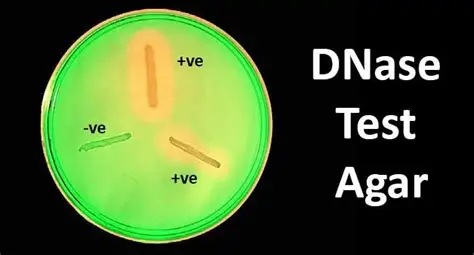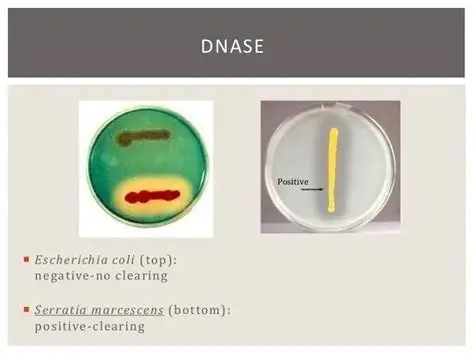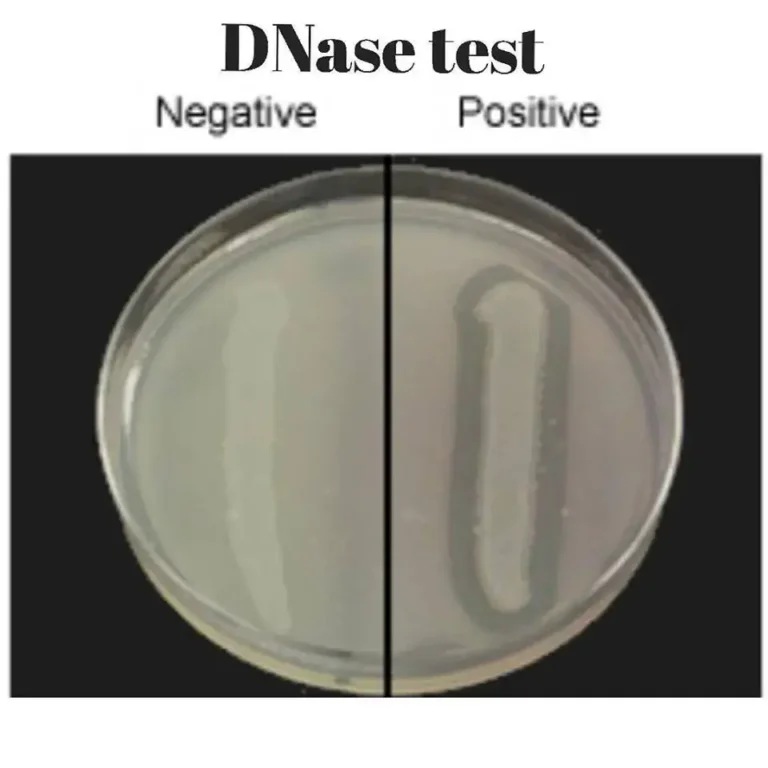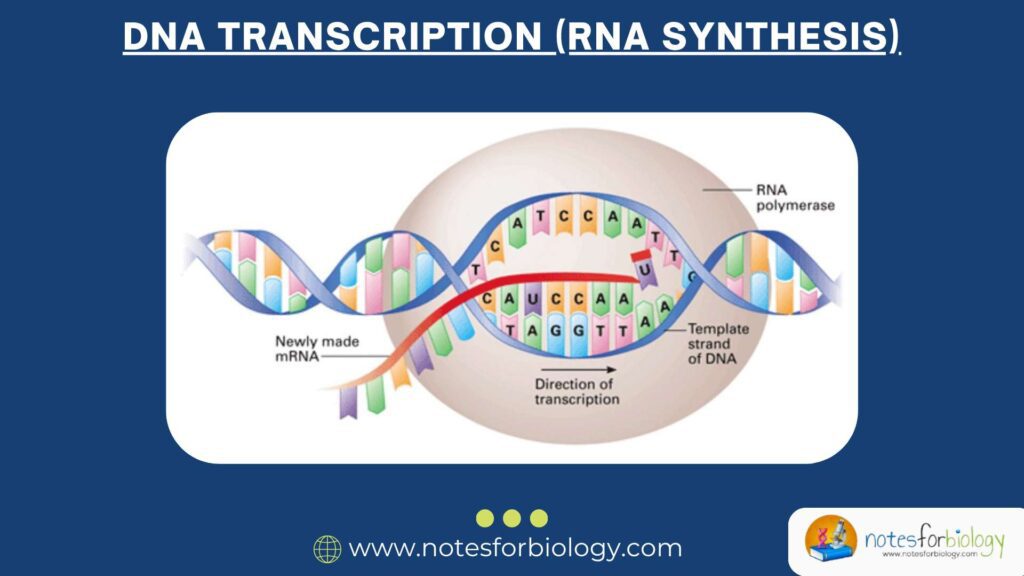Introduction
Microorganisms possess a wide range of enzymes that help them survive and adapt in diverse environments. One such enzyme is deoxyribonuclease (DNase), which breaks down DNA molecules. In the field of microbiology and clinical diagnostics, detecting this enzyme can help identify certain bacterial species. This is where the DNase test comes into play.

The DNase test is a simple yet powerful biochemical test that detects the presence of the DNase enzyme produced by bacteria. This enzyme allows bacteria to hydrolyze DNA into smaller fragments. By detecting this activity, microbiologists can differentiate between bacterial species, especially in medical diagnostics.
This document provides a comprehensive and easy-to-understand explanation of the DNase test. We will cover its definition, working principle, materials needed, step-by-step procedure, interpretation of results, significance, and various applications—all in a simple and humanized form.
Table of Contents
Definition of the DNase Test
The DNase test is a microbiological test used to determine whether a microorganism produces the enzyme deoxyribonuclease (DNase), which can degrade DNA.

When a bacterium secretes DNase, it breaks down DNA in the surrounding medium into smaller molecules like nucleotides and oligonucleotides. The breakdown of DNA can be observed directly using special media and indicators, allowing us to identify DNase-positive organisms.
In simpler terms, the DNase test helps us find out if a bacterium has the ability to “digest DNA”, which can be a clue about its identity and possible virulence.
Importance of the DNase Enzyme
DNase (deoxyribonuclease) is an enzyme that breaks phosphodiester bonds in the DNA backbone. Bacteria that produce DNase use this enzyme for:
- Nutrient acquisition from host DNA
- Evading the host immune system
- Destroying host cell DNA during infection
- Competing with other microbes in the environment
Some pathogenic bacteria use DNase as a virulence factor, meaning it helps them cause disease. For example, Staphylococcus aureus, a major human pathogen, produces DNase, while the closely related Staphylococcus epidermidis usually does not.
Principle of the DNase Test
The DNase test is based on the ability of certain bacteria to produce DNase, which hydrolyzes DNA present in the culture medium. This DNA is mixed with indicators like methyl green or toluidine blue, or used without indicators but revealed later with hydrochloric acid (HCl).
Here’s how it works:
- The medium contains DNA, either with or without a dye.
- If the organism produces DNase, it breaks down DNA around its colony.
- In dye-containing media, a color change occurs due to DNA degradation.
- In dye-free media, after adding HCl, undigested DNA precipitates, while digested DNA does not—creating a clear zone around DNase-positive colonies.
The presence of a clear halo or colorless zone around the bacterial growth indicates DNase activity.
Composition of DNase Test Medium
The medium used for the DNase test is known as DNase agar. It can be prepared with or without dyes. The standard components include:
- DNA (deoxyribonucleic acid): Substrate for DNase
- Peptone: Provides nitrogen and other nutrients
- Sodium chloride (NaCl): Maintains osmotic balance
- Agar: Solidifying agent
- Indicator dye (optional):
- Methyl green: Green in color when bound to DNA; fades when DNA is degraded
- Toluidine blue: Changes color when bound to degraded DNA
Alternatively, dye-free DNase agar can be used with 1N HCl as a post-incubation reagent.
Types of DNase Test Media
1. DNase Agar with Methyl Green
- Contains methyl green-DNA complex
- DNase activity releases the dye, creating clear/colorless zones
- Easier to observe without reagent
2. DNase Agar with Toluidine Blue
Turns pink when DNA is hydrolyzed due to a shift in the dye’s color
3. DNase Agar without Indicator
- Requires flooding the plate with 1N hydrochloric acid after incubation
- DNA precipitates with HCl; degraded DNA does not, forming clear zones
Materials Required
- DNase agar plates (with or without dye)
- Bacterial culture (pure colony)
- Inoculating loop or needle
- Incubator (35–37°C)
- 1N hydrochloric acid (if using indicator-free medium)
- Sterile saline or distilled water (for preparation)
- Bunsen burner or spirit lamp (for sterilization)
Procedure of the DNase Test
The DNase test is generally carried out on agar plates. Here’s a step-by-step guide:
Step 1: Preparation of Media
- If using commercially prepared plates, skip this step.
- If preparing in the lab, dissolve DNase agar powder in distilled water.
- Sterilize by autoclaving.
- Pour into sterile Petri dishes and allow to solidify.
Step 2: Inoculation
- Use a sterile inoculating loop or needle.
- Touch a colony of the test organism and streak a line or spot inoculate onto the surface of the DNase agar.
- You may also inoculate a control organism (known positive and negative) on the same plate for comparison.
Step 3: Incubation
- Incubate the plates at 35–37°C for 24–48 hours.
- For fast-growing organisms, 24 hours is usually enough.
- Plates should be incubated inverted to avoid condensation.
Step 4: Post-Incubation Observation
For Plates with Indicator Dye:
- Examine the plate under normal lighting.
- Look for clear or colorless zones around the colonies.
For Plates without Indicator Dye:
- Flood the plate with 1N HCl (10 mL per plate).
- Let it stand for 3–5 minutes.
- Undigested DNA will precipitate, turning the agar cloudy.
- A clear halo around colonies indicates DNA degradation.
Result Interpretation

Positive DNase Test
- Clear zone or colorless halo around bacterial growth
- Indicates production of DNase enzyme
Examples of DNase-positive organisms:
- Staphylococcus aureus
- Serratia marcescens
- Moraxella catarrhalis
- Campylobacter jejuni
- Aeromonas hydrophila
Negative DNase Test
- No clear zone or color change
- The area around the colony remains green (methyl green) or blue (toluidine blue) or becomes opaque (after HCl)
Examples of DNase-negative organisms:
- Staphylococcus epidermidis
- Escherichia coli
- Enterococcus faecalis
Quality Control for DNase Test
It is essential to use positive and negative control strains to ensure the reliability of the DNase test.
- Positive Control: Staphylococcus aureus
- Negative Control: Staphylococcus epidermidis
These controls help validate the performance of the medium and technique.
Applications and Uses of DNase Test
1. Identification of Bacterial Species
The DNase test helps differentiate and identify various bacterial species based on their ability to produce DNase.
Examples:
- Differentiates Staphylococcus aureus (DNase-positive) from Staphylococcus epidermidis (DNase-negative)
- Distinguishes Serratia marcescens from Enterobacter species
2. Detection of Virulence Factors
DNase is considered a virulence factor, especially in pathogenic bacteria. Detecting DNase helps in:
- Understanding disease mechanisms
- Studying bacterial pathogenicity
- Identifying potentially harmful strains
3. Clinical Microbiology
Used in routine diagnostic laboratories to assist in identifying clinically significant bacteria in:
- Skin and wound infections
- Respiratory tract infections
- Bloodstream infections
4. Food and Water Microbiology
DNase-producing bacteria can spoil food or contaminate water. DNase testing helps detect such organisms during quality control.
5. Pharmaceutical and Research Applications
- Studying gene regulation and enzyme function
- Identifying targets for antibiotics or enzyme inhibitors
6. Veterinary Microbiology
DNase test is used to identify pathogens in animals, such as Mannheimia haemolytica in livestock.
Limitations of the DNase Test
- Interpretation can be subjective, especially with weak DNase activity
- Overgrowth of bacteria may obscure zone of clearance
- Some strains may show delayed DNase activity
- Not all pathogenic bacteria produce DNase
- Must be used along with other tests for accurate identification
Safety and Precautions
- Use aseptic technique to prevent contamination
- Always include control organisms
- Dispose of bacterial cultures and reagents safely
- Handle HCl with care—wear gloves and goggles
- Use proper incubation times; under or over incubation may alter results
Tips for Reliable Results
- Use fresh DNase agar plates (dye stability can degrade over time)
- Incubate at the right temperature
- Don’t overload the plate with too many organisms
- Use appropriate controls every time
- Avoid letting the agar dry out
Variations of DNase Testing
DNase Test in Liquid Medium
Some researchers use liquid DNase detection systems involving spectrophotometry or absorbance changes. These are mostly used in research and are not common in clinical labs.
DNase Activity Assays
Quantitative methods using fluorescent dyes or absorbance readings help measure the exact activity of DNase enzymes. These are used in advanced microbiological and biochemical studies.
Clinical Relevance of DNase Production
DNase-producing organisms are often more virulent because they can:
- Break down host DNA and escape immune traps (like neutrophil extracellular traps or NETs)
- Digest pus and tissue barriers
- Spread through host tissues more efficiently
Thus, DNase testing is not just a tool for identification but also for understanding how dangerous a bacterial strain might be.
Future Perspectives
With the rise of antibiotic-resistant bacteria, understanding enzymatic profiles like DNase production can help in:
- Developing targeted therapies
- Designing vaccines or inhibitors
- Improving diagnostic tools using molecular DNase markers
Emerging methods may combine DNase testing with genomic tools, point-of-care devices, or biosensors for faster results in clinical and environmental microbiology.
Conclusion
The DNase test is a classic yet highly valuable diagnostic method in microbiology. By detecting the presence of DNase enzyme, this test helps microbiologists and clinicians differentiate between closely related bacterial species and assess their potential to cause disease.
From a single streak on a Petri dish, the DNase test reveals essential biological behavior. Its simplicity, cost-effectiveness, and reliability make it a must-have tool in labs around the world. Whether you are a student, a microbiologist, or a clinician, understanding how to perform and interpret the DNase test is a fundamental skill in the study of bacteria.
Three Key Summary
- The DNase test detects the enzyme deoxyribonuclease, which breaks down DNA in the culture medium.
- A clear zone around the colony on DNase agar indicates DNase production and helps identify pathogenic bacteria like Staphylococcus aureus.
- It is widely used in microbiology for bacterial identification, virulence factor analysis, and clinical diagnostics.
FREQUENTLY ASKED QUESTIONS
What is the purpose of adding hydrochloric acid in the DNase test?
HCl precipitates the unhydrolyzed DNA in the medium. In DNase-positive cultures, DNA is degraded and does not precipitate, creating a clear zone.
Is DNase production a definitive test for identifying bacteria?
No. While helpful, DNase production should be used in combination with other biochemical tests for accurate identification.
Can DNase test be performed in liquid medium?
Yes, though it’s less common. Spectrophotometric methods can measure DNase activity in liquid cultures, especially in research settings.
Related Articles




